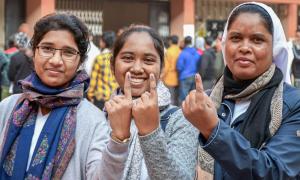I met an eminent economist who quoted another eminent economist and columnist to ask if it was true that apples had higher pesticide residues than Coke or Pepsi. Before I could respond, he looked me straight in the eye and said, "and is it not true that mothers milk has pesticide".
Evidently, spin-doctors of the soft drink companies combined with actress Rani Mukerjee, who pouts on advertisements, "if the air is dirty should we not breath", had wormed their way into their economist-trained minds.
I wont call them gullible because economists are not expected to read beyond the numbers -- is it more or less, is it up or down? And yes, it is true that pesticides we detected in soft drinks were lower than the standards prescribed for pesticide residues in milk or apples for that matter. But that is not the point.
| |||||||||||
This is how the story begins. Industry-inventors of chemicals and scientists work to determine what is the safe dose of a particular pesticide. They determine, what is called an acceptable daily intake of each pesticide -- that is, what is safe to take daily, over a lifetime, for what age and body weight.
Safety is defined as the dose that must not be exceeded each day, of a particular pesticide. Based on the toxicity of a pesticide, the dose will differ. The dose will also differ based on the weight and age of the person.
So, it may be "safe" to ingest 0.3 mg of lindane for an adult with a bodyweight of 60 kg, but a child with a bodyweight of 10 kg is only allowed 0.05 mg of lindane each day, for instance.
The next step is to determine our exposure to the particular pesticide each day. How is this done?
First, scientists supervise pesticide usage in different crops and measure what is the minimum pesticide residue level that is achievable under good agricultural practices. This determines the maximum residue level that should be set for each food for that particular pesticide. This MRL -- or what is the least amount of pesticide that can be legally accepted -- is then used to calculate exposure.
Exposure, as you will guess, is through the food we eat. Regulators have to calculate what we eat -- literally down to each apple, if possible -- and then based on what pesticide residues are permitted in the product, that is the MRL, estimate our total exposure to that particular pesticide.
The challenge is if the regulator finds in this calculation that the exposure to the pesticide will be higher than the ADI, work begins again. Scientists have to reduce the amount of pesticides that can be permitted in each crop and food items so that the total intake of the toxin is reduced.
Global regulators -- the Food and Agriculture Organisation and the World Health Organisation -- have developed regional diet charts to help estimate our exposure to pesticides. But they say that each country, which uses and registers pesticides, must do its own homework and must ensure that exposure to each pesticide, under no circumstances, exceeds the acceptable daily intake. That would be deadly. Indeed, it would be criminal.
Now what has all this got to do with soft drinks or apples? The answer is in the modern interpretation of an old adage -- an apple a day keeps the doctor away but a soft drink certainly does not.
Let me explain. What is "safe" means calculating what we eat, how much we eat and how much pesticide is allowed in the food we eat. Therefore, the food basket is also the pesticide basket.
Put simply, we have to eat pesticides because we have to eat food for nutrition but we must not exceed our quota because that would be deadly. Call this the nutrition and poison trade-off.
It will come as no surprise that soft drinks are never included in the global or national diet calculations. Soft drinks are not essential foods, at least not till now.
Therefore, if any pesticide residues are allowed in a soft drink as "safe", the drink will have to be substituted with something else we eat (not drink, because water is still not adjusted into the daily diet). What would the economists want us to substitute soft drinks with -- milk? Apples? Fruit juices? Cereals?
Safety, therefore, is about setting and adhering to the standards for pesticide residue in the food product. If no standard has been set, then the product -- soft drinks in this case -- has no "business" to have any pesticide residue. It is unsafe. It is unacceptable.
Safety is also not in large numbers. Tiny and continuous exposure to a cocktail -- multiple residues -- of pesticides in soft drinks will be deadly.
Call these drinks safe? Only if you are acting. Like Aamir Khan.







More from rediff